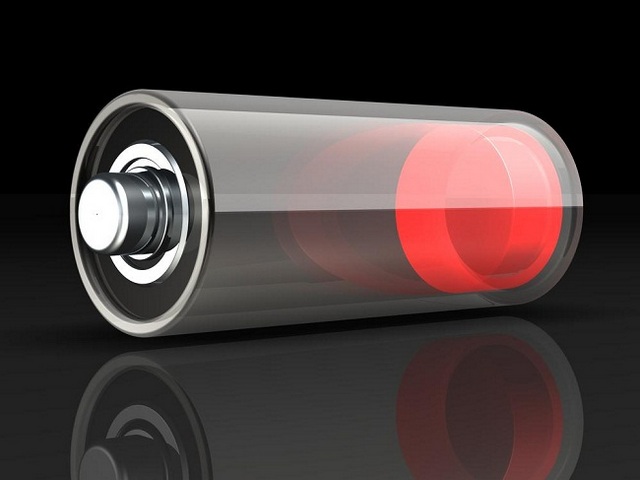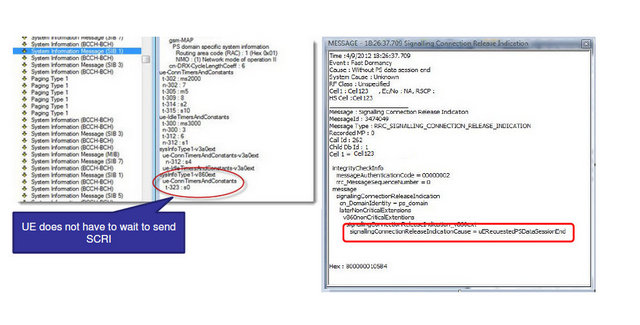There are many way to waste UE battery power but there are some ways to save this rare and useful resource. Fast Dormancy is one of these. Fast dormancy was introduced in 3GPP release 8 of the specifications after that it was a huge hit among all the smart phone manufacturers. The basic principle behind Fast Dormancy is quite simple “Save phone power when it is inactive”.

So is it like before fast dormancy smartphone were draining all the power in no time? The answer is NO. Fast dormancy is a technical name 3GPP adapted. Before the standardisation many proprietary algorithms were used to solve this issue which some times termed as “Autonomous Signalling Connection Release”. This terminology may be differ between vendors. But the concepts are identical.
3GPP standards says that UE should send a “Signalling Connection Release Indication” to network with release cause set to “UE Requested PS Data session end”. This will terminate the signalling when UE is in absolute inactive state.
To know what is inactive state lets check out what UE (RRC) state are defined in 3GPP.
RRC Idle State
In Idle state no RRC connection exists and UE consumes the least power in this state. UE only transmits some signalling in rare occasions like “Location area update” and “Routing area update”. Apart from that UE monitors the Common Pilot Channel (CPICH) of the cell where it is camped. UE RRC connection is disconnected, so for doing some operation RRC connection is established.
PCH State
PCH state is similar to Idle (Not literally). The UE is RRC connected to UTRAN but no user data is sent. The biggest advantage of PCH is that UE does not need to establishing RRC connection when needed as RRC is in a connected state. UE can operate at very low power consumption, which is determined by the DRX cycles of the PCH states. In the following sections the PCH state could be either deployed by using Cell_PCH or URA_PCH or both.
CELL_PCH State
In CELL PCH UE need to inform UTRAN whenever it camps on a new cell which belongs to a different location area. In case when location area is changes UE need to move to do a cell update to move to CELL_FACH state for a limited period of time to sen CELL UPDATE message. UE listens to the same channels as idle and the radio wakes up every DRX cycle.
URA_PCH State
Similar to CELL PCH but updates are only sent when UTRAN Registration area is changes. As UTRAN registration area is a bigger geographical area so updates are sent less frequent than CELL_PCH state.
CELL_FACH State
In CELL FACH state UE is in connected mode using common or shared channels. This state is good for sending small amount of data. In uplink RACH (Random Access Channel) is used and in the downlink FACH (Foreword Access Channel) is used.
CELL DCH State
CELL DCH is the power consuming state. UE is connected using DCH (Dedicated Channel) or High Speed Shared Channel(HSDSCH) or Enhanced Dedicated Channel (EDCH). Only in CELL DCH state high volume of date packets are transmitted or received.
Here is an approximate comparison of battery power consumption in different states:
Idle = 1 (relative units)
Cell_PCH < 2 (this depends on the DRX ratio with Idle and the mobility)
URA_PCH ≤ Cell_PCH ( < in mobility scenarios, = in static scenarios)
Cell_FACH = 40 x Idle
Cell_DCH = 100 x Idle
How Fast Dormancy Works?
3GPP RRC was initially designed with CELL_PCH state and URA_PCH state to allow UEs to consume less power. But many networks are configured with relatively long inactivity timers for CELL_DCH, CELL_FACH states. So even for transmitting a small amount of data a lot of UE power is wasted.
There were many proprietary fast dormancy methods implemented before it’s standardised. In proprietary implementations UE sends a simulated Signalling Connection Release Indication to RNC. But the problem occurs when UE needs to set up signaling connection again. In some instances UE need to set up more than 25 connections in less than 5 minute period in commercial HSPA network, which is a lot of signaling traffic.

In 3GPP release 8 fast dormancy was standardised. According to the standards UE can send Signalling Connection Release Indication to the network to show its intention for releasing the packet conniption but network is in care of the whole process. This is called network controlled fast dormancy.
The network sends a inhibit timer (T323) to UE in system information block type 1 (SIB1). Timer T323 tells how much time the UE need to wait before sending the next Signalling Connection Release Indication Message. The presence of T323 timer indicates that the network supports fast dormancy.
Release 8 fast dormancy is well described in WCDMA for UMTS: HSPA Evolution and LTE by Harri Holma and Antti Toskala. Also refer to 3GPP 25.331 (RRC) specification for more details.

Permalink
How do we know whether UE supports Fast Dormacy feature ? RRC Connection request shows release version of UE but it does shows whether fast dormacy is supported? We have experienced a some issues where UE will be supporting Release 8 but it is not supporting Fast dormacy ? –prakashnpk@gmail.com
Permalink
Many times these features are configuration dependent, means the fast dormancy feature will be there in UE modem but need to be activated. Can you ask the UE modem team?
Permalink
there is no specifc capabilty or this
RNC can remember the imsi of ue sending signalling connection relese with cause ps data session end